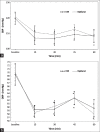Changes in cardiac index during labour analgesia: A double-blind randomised controlled trial of epidural versus combined spinal epidural analgesia - A preliminary study
- PMID: 28515516
- PMCID: PMC5416718
- DOI: 10.4103/ija.IJA_641_16
Changes in cardiac index during labour analgesia: A double-blind randomised controlled trial of epidural versus combined spinal epidural analgesia - A preliminary study
Abstract
Background and aims: Combined spinal-epidural (CSE) analgesia for labour and delivery is occasionally associated with foetal bradycardia. Decreases in cardiac index (CI) and/or uterine hypertonia are implicated as possible aetiological factors. No study has evaluated CI changes following combined spinal analgesia for labour and delivery. This prospective, double-blind, randomised controlled trial evaluates haemodynamic trends during CSE and epidural analgesia for labour.
Methods: Twenty-six parturients at term requesting labour analgesia were randomised to receive either epidural (E) or CSE analgesia. The Electrical Cardiometry Monitor ICON® was used to continuously determine maternal CI non-invasively, heart rate (HR) and stroke volume at baseline and up to 60 min after initiation of either intrathecal or epidural analgesia. In addition, maternal systolic blood pressure (SBP) and diastolic blood pressure (DBP) were recorded.
Results: Both SBP and DBP had a similar, significant decrease following initiation of either epidural or CSE analgesia. However, parturients in the CSE group (n = 10) demonstrated a significant decrease in HR and CI compared to the baseline measurements. On the other hand, the parturients in the E (n = 13) group showed no decreases in either maternal HR or CI. Foetal heart changes were observed in four patients following CSE and one patient following an epidural.
Conclusion: Labour analgesia with CSE is associated with a significant decrease in HR and CI when compared to labour analgesia with epidural analgesia. Further studies are necessary to determine whether a decrease in CI diminishes placental blood flow.
Keywords: Cardiac output; combined spinal epidural; epidural labour analgesia.
Conflict of interest statement
There are no conflicts of interest.
Figures





Similar articles
-
Combined spinal-epidural analgesia in labour: its effects on delivery outcome.Braz J Anesthesiol. 2016 May-Jun;66(3):259-64. doi: 10.1016/j.bjane.2014.09.006. Epub 2014 Nov 28. Braz J Anesthesiol. 2016. PMID: 27108822
-
[Combined spinal-epidural analgesia in labour: its effects on delivery outcome].Rev Bras Anestesiol. 2016 May-Jun;66(3):259-64. doi: 10.1016/j.bjan.2014.09.009. Epub 2016 Mar 15. Rev Bras Anestesiol. 2016. PMID: 26993410 Portuguese.
-
Prophylactic intravenous ephedrine to minimize fetal bradycardia after combined spinal-epidural labour analgesia: a randomized controlled study.Can J Anaesth. 2015 Nov;62(11):1201-8. doi: 10.1007/s12630-015-0450-8. Epub 2015 Aug 14. Can J Anaesth. 2015. PMID: 26272720 Clinical Trial.
-
Intrathecal opioids for combined spinal-epidural analgesia during labour.CNS Drugs. 2003;17(12):889-904. doi: 10.2165/00023210-200317120-00003. CNS Drugs. 2003. PMID: 12962528 Review.
-
Meta-analysis of the success of block following combined spinal-epidural vs epidural analgesia during labour.Anaesthesia. 2014 Jan;69(1):64-71. doi: 10.1111/anae.12456. Epub 2013 Oct 28. Anaesthesia. 2014. PMID: 24164577
Cited by
-
'Advances in understanding and management in obstetric anaesthesia': The great myth of our times.Indian J Anaesth. 2017 Apr;61(4):285-288. doi: 10.4103/ija.IJA_209_17. Indian J Anaesth. 2017. PMID: 28515514 Free PMC article. No abstract available.
References
-
- Gambling DR, Sharma SK, Ramin SM, Lucas MJ, Leveno KJ, Wiley J, et al. A randomized study of combined spinal-epidural analgesia versus intravenous meperidine during labor: Impact on cesarean delivery rate. Anesthesiology. 1998;89:1336–44. - PubMed
-
- Skupski DW, Abramovitz S, Samuels J, Pressimone V, Kjaer K. Adverse effects of combined spinal-epidural versus traditional epidural analgesia during labor. Int J Gynaecol Obstet. 2009;106:242–5. - PubMed
-
- Segal S, Wang SY. The effect of maternal catecholamines on the caliber of gravid uterine microvessels. Anesth Analg. 2008;106:888–92. - PubMed
-
- Segal S, Csavoy AN, Datta S. The tocolytic effect of catecholamines in the gravid rat uterus. Anesth Analg. 1998;87:864–9. - PubMed
-
- Abrão KC, Francisco RP, Miyadahira S, Cicarelli DD, Zugaib M. Elevation of uterine basal tone and fetal heart rate abnormalities after labor analgesia: A randomized controlled trial. Obstet Gynecol. 2009;113:41–7. - PubMed
LinkOut - more resources
Full Text Sources
Other Literature Sources

